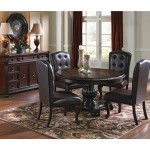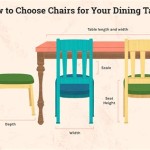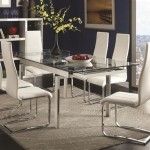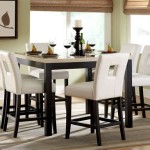Dining Room Table For 10: Size and Considerations
Selecting the optimal dining room table for ten individuals requires careful consideration of space, shape, materials, and intended use. A table that comfortably accommodates ten diners is a significant investment, and understanding the nuances of size and dimensions is crucial for making an informed decision that aligns with both aesthetic preferences and practical requirements.
The primary factor governing the selection process is the available space within the dining room. Measuring the room accurately and understanding the flow of traffic around the table are essential prerequisites. A table that is too large will impede movement, create a cramped atmosphere, and negatively impact the overall dining experience. Conversely, a table that is too small will not adequately serve the intended purpose of seating ten people comfortably. Therefore, a balanced approach is required, prioritizing both functionality and spatial harmony.
Beyond size, the shape of the table is another critical element to contemplate. Rectangular, oval, and round tables offer distinct advantages and disadvantages in terms of seating capacity, conversation dynamics, and overall room aesthetics. The chosen shape should complement the architectural style of the dining room and facilitate a comfortable and engaging dining environment.
Minimum Size Requirements for a Dining Table Seating 10
Determining the minimum size of a dining room table for ten people involves understanding the space required per diner. A general rule of thumb is to allocate approximately 24 inches of width per person to ensure adequate elbow room and prevent overcrowding. This measurement allows diners to comfortably eat without feeling cramped or encroaching on their neighbor's space. In addition to width, depth is also crucial; a minimum table depth of 36 inches is generally recommended to accommodate serving dishes, centerpieces, and other dining essentials.
For a rectangular table, the minimum recommended size is typically 84 inches in length and 36 inches in width. This configuration provides sufficient seating for ten people, with five individuals seated along each longer side of the table. However, this is a bare minimum, and a slightly larger table, such as 96 inches long, offers a more comfortable and less cramped experience for diners. The extra length allows for greater spacing between individuals and provides additional room for serving dishes without compromising personal space.
Oval tables, due to their curved ends, can sometimes accommodate slightly more people within a smaller footprint compared to rectangular tables. However, similar principles apply regarding the allocation of 24 inches of width per person. An oval table suitable for ten people would typically measure approximately 72 inches in diameter at its widest point and approximately 48 inches in width. The exact dimensions will vary depending on the specific shape and curvature of the table. It's important to consider that oval tables may present challenges in terms of placing serving dishes in the center, as the curvature might limit access for some diners.
Round tables present a unique set of considerations. While conducive to conversation and creating a sense of intimacy, they often require a larger overall footprint to accommodate the same number of people as rectangular or oval tables. A round table that comfortably seats ten people would need to have a diameter of at least 60 inches. However, a larger diameter, such as 72 inches, is often preferred to provide ample space for each diner and to avoid a feeling of being overly crowded. The challenge with round tables lies in ensuring that all diners can easily reach serving dishes placed in the center without having to stretch or lean excessively.
Impact of Table Shape on Dining Experience and Room Aesthetics
The shape of a dining room table significantly influences the overall dining experience and the visual appeal of the room. Rectangular tables are the most common and versatile choice, often favored for their ability to maximize seating capacity and fit seamlessly into a variety of room layouts. Their straight lines contribute to a sense of formality and order, making them well-suited for traditional and contemporary dining rooms alike. Rectangular tables also offer ample space for elaborate centerpieces and serving platters, making them ideal for formal dinners and gatherings.
Oval tables offer a softer and more elegant alternative to rectangular tables. Their rounded edges create a sense of flow and harmony, softening the overall look of the room. Oval tables are often perceived as being more inviting and conducive to conversation, as they eliminate the sharp corners that can create a sense of division. This shape is particularly well-suited for smaller dining rooms, as the rounded edges can help to create the illusion of more space. However, as previously mentioned, the curvature can sometimes present challenges in terms of accessing serving dishes placed in the center.
Round tables foster a sense of intimacy and equality among diners. As there is no head of the table, all individuals are positioned equidistant from the center, promoting a more egalitarian and inclusive dining experience. Round tables are particularly well-suited for casual gatherings and intimate dinners, where fostering conversation and connection is a priority. However, they can be less practical for larger gatherings or formal occasions, as they often require a larger overall footprint and may limit the amount of serving space available. The circular shape also necessitates careful consideration of the surrounding furniture and décor to ensure a cohesive and balanced aesthetic.
Beyond the seating arrangement and the ambiance, the shape of the table can also influence the flow of traffic within the dining room. Rectangular tables, particularly those placed lengthwise in a narrow room, can sometimes create bottlenecks and impede movement. Oval and round tables, on the other hand, tend to promote a more fluid and circular flow, making it easier for guests to navigate the space. Careful consideration should be given to the placement of the table in relation to doorways, windows, and other furniture to ensure a comfortable and functional dining environment.
Material Considerations and Structural Integrity
The choice of material for a dining room table not only affects its aesthetic appeal but also its durability, maintenance requirements, and overall longevity. Common materials include wood, glass, metal, and stone, each offering distinct advantages and disadvantages. The selection should align with the desired style, budget, and anticipated usage of the table.
Wood is a classic and versatile choice, offering a wide range of options in terms of species, finishes, and styles. Hardwoods such as oak, maple, and cherry are known for their durability and resistance to scratches and dents, making them well-suited for high-traffic dining rooms. Softer woods like pine and cedar offer a more rustic aesthetic but may be more susceptible to damage. Regardless of the species, a high-quality finish is essential to protect the wood from moisture, stains, and other forms of wear and tear. Wood tables require regular cleaning and occasional polishing to maintain their beauty and integrity.
Glass tables offer a sleek and modern aesthetic, creating a sense of openness and lightness in the dining room. Tempered glass is the preferred choice for dining tables due to its strength and resistance to shattering. However, glass tables can be prone to fingerprints and smudges, requiring more frequent cleaning than wood tables. The base of a glass table is typically made of metal or wood and should be sturdy enough to support the weight of the glass and the diners seated around it. The transparency of glass can be advantageous in smaller dining rooms, as it allows light to pass through and create the illusion of more space.
Metal tables offer a contemporary and industrial aesthetic, often incorporating elements such as steel, iron, or aluminum. Metal tables are generally very durable and resistant to damage, making them a practical choice for households with children or pets. However, metal can be cold to the touch and may require the use of placemats or tablecloths to create a more comfortable dining surface. The finish of a metal table is crucial to its longevity, as a poor-quality finish can be prone to rust or corrosion. Powder coating is a common and durable finish option for metal tables, providing a protective layer against the elements.
Stone tables, such as those made from marble, granite, or slate, offer a luxurious and sophisticated aesthetic. Stone is incredibly durable and resistant to heat, scratches, and stains, making it a long-lasting investment. However, stone tables can be very heavy and require professional installation. They are also porous and may require sealing to prevent staining from spills. The weight of a stone table also necessitates a strong and sturdy base to ensure stability and prevent damage to the flooring. Stone tables are often more expensive than other types of dining tables, reflecting their high-quality materials and craftsmanship.
Beyond the material of the tabletop, the structural integrity of the table base is paramount. A well-designed and constructed base provides stability and support, ensuring that the table can withstand the weight of diners and serving dishes without wobbling or collapsing. Consider the joinery and construction techniques used in the base, as these factors will directly impact the table's overall durability and longevity. Solid wood legs, metal frames, and well-reinforced joints are all indicators of a high-quality base.

Pin On Dining Room Redo

How To Choose The Right Dining Table Size And Shape Contemporary Wooden Furniture Hand Made In Cincinnati Ohio Modern Traditional Craft

Table Dimensions Yahoo Search Results Image In 2024 Large Dining Room Sizes

All World Furniture Mobília De Jantar Layout Restaurante Decoração Da Sala

The Right Size Dining Table For Your Space

What Size Dining Table Should I Buy Rustic Chic Design Large Room Sizes Dimensions

4 Steps For Buying A Dining Table Guide Sizes Home Decor Shelves Rustic

Standard Dining Table Dimensions The Size Guide

Table Size Advisor Which Is Right For Me

Dream Gold Steel Dining Table Base 10 Seater Size Standard








